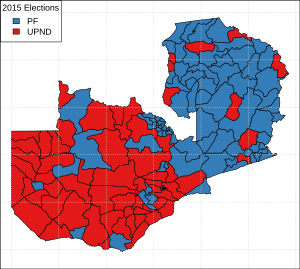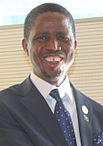Zambian presidential election, 2015
|
|
|||||||||||||||||
|---|---|---|---|---|---|---|---|---|---|---|---|---|---|---|---|---|---|
|
|||||||||||||||||
|
5,166,088 registered voters Simple majority votes needed to win |
|||||||||||||||||
| Turnout | 32.36% | ||||||||||||||||
|
|||||||||||||||||

|
|||||||||||||||||
|
|||||||||||||||||
Presidential elections were held in Zambia on 20 January 2015 to elect a president to serve the remainder of the term of President Michael Sata, following his death on 28 October 2014.
The ruling Patriotic Front candidate Edgar Lungu won by a narrow majority of just 27,757 votes (1.66%) against Hakainde Hichilema of the United Party for National Development. Hichilema denounced the elections as a sham and urged his supporters to remain calm.
Prior to Sata's death, his ill-health led to political commentators speculating about potential Patriotic Front candidates. Following his death on 28 October, Vice-President Guy Scott became acting president and became the first non-Arab white head of state on the African continent since Apartheid-era South Africa's F. W. de Klerk.
The constitution required that elections be held within 90 days of the death of an incumbent president. On 18 November, Scott announced the election date, which also launched the campaigning period.
On 27 February 2014, the Opposition Alliance was formed to field a common candidate in the 2016 elections. The alliance consisted of the Movement for Multi-Party Democracy (MMD), the Alliance for Better Zambia, Zambians for Empowerment and Development, the People's Party, and the All People's Congress Party. However, following the death of President Sata and the calling of early elections, however, MMD Deputy National Secretary Chembe Nyangu expressed doubts about whether the alliance would work given the short time period to agree on a candidate.
...
Wikipedia


